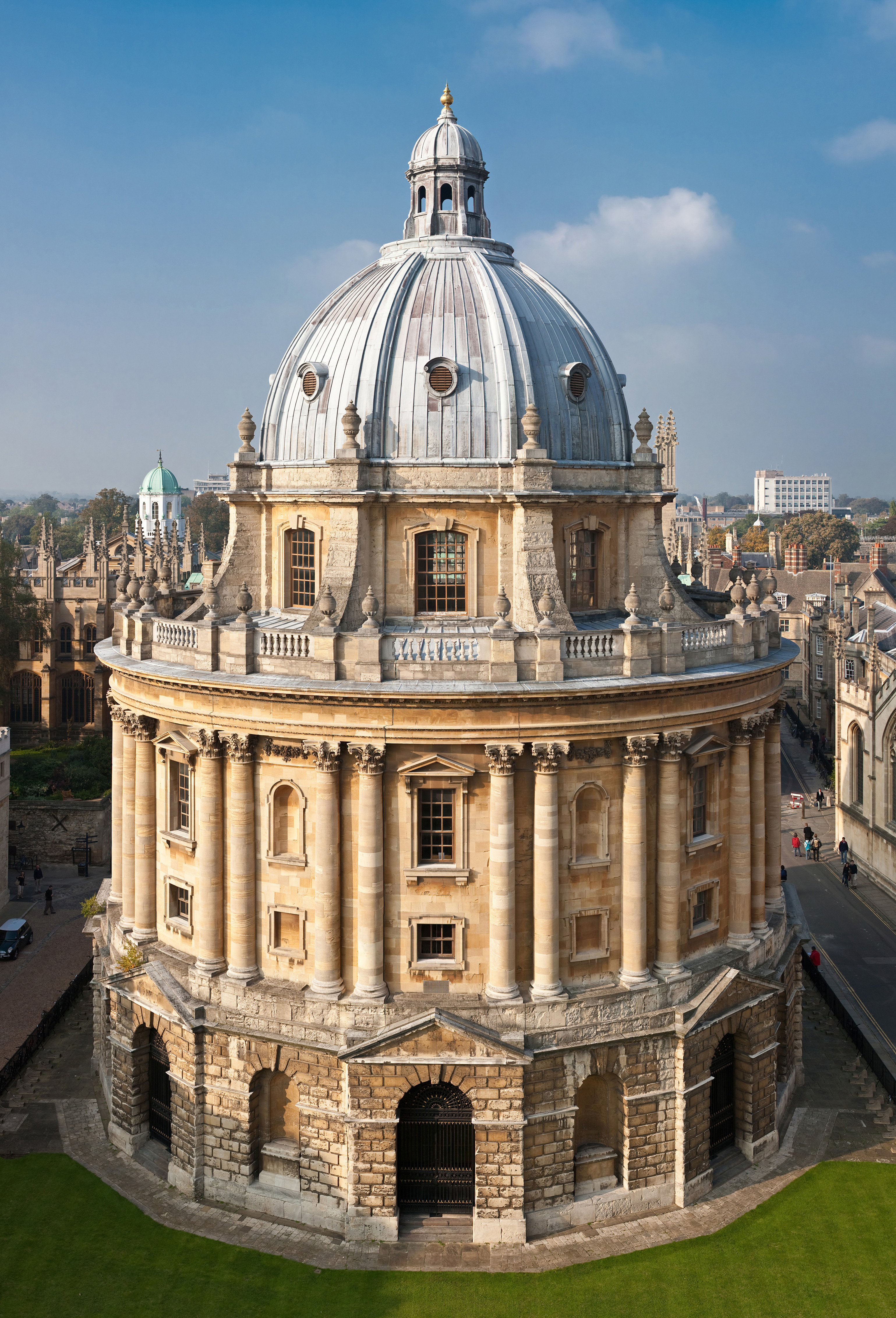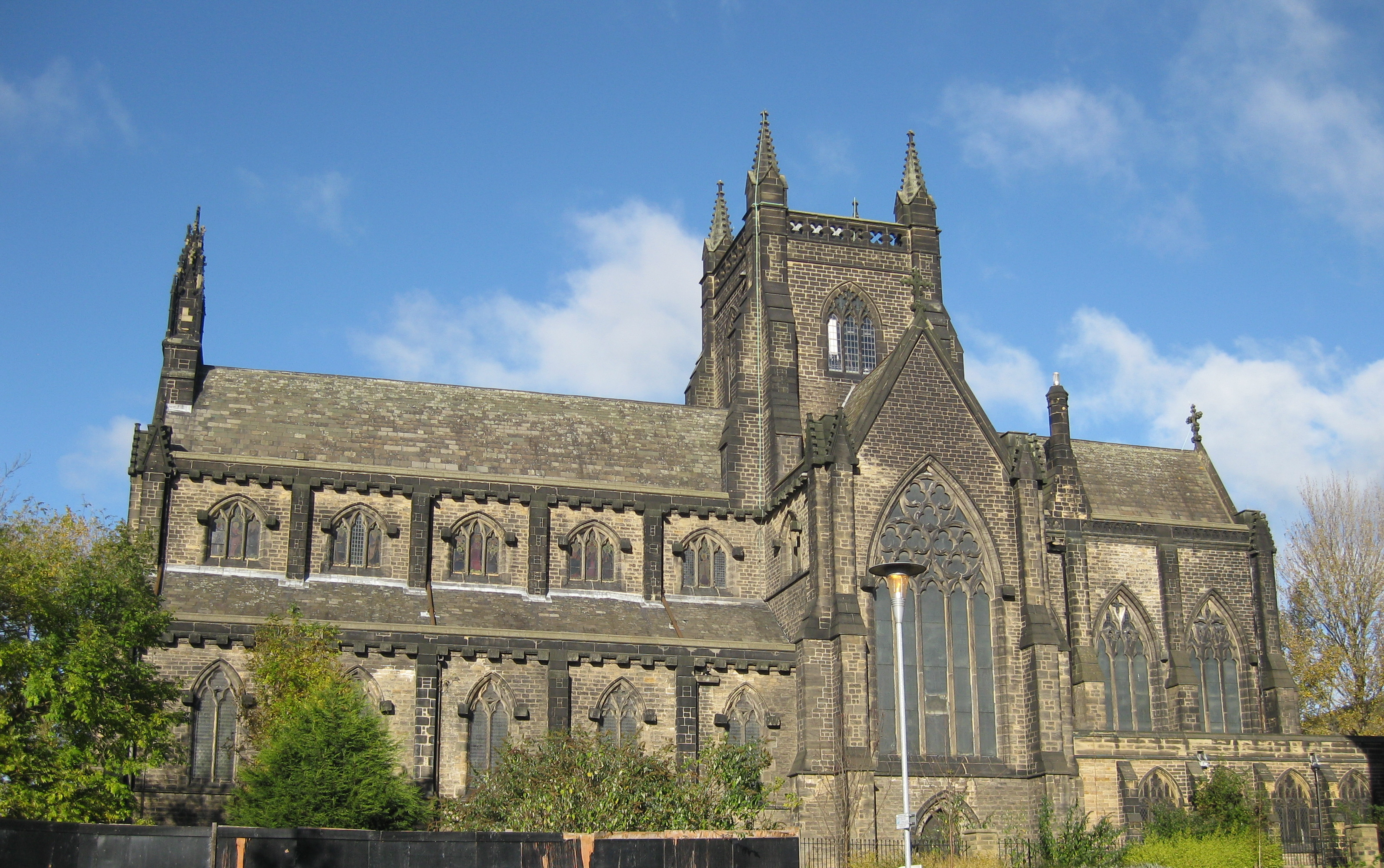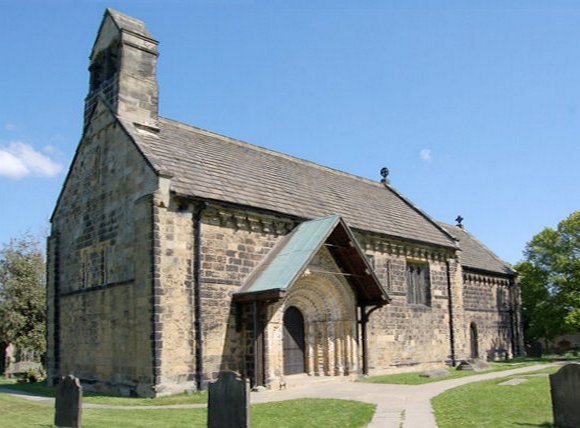|
St Saviour Church, Richmond Hill
St Saviour Church in Richmond Hill, Leeds, West Yorkshire, England is an active Anglican parish church in the archdeaconry of Leeds and the Diocese of Leeds. History The church was built between 1842 and 1845 to designs by architect John Macduff Derick. The church was anonymously funded by Edward Bouverie Pusey, Regius Professor of Hebrew at Oxford, a leading advocate of the Oxford Movement. A tall spire, modelled on the spire of St Mary's, Oxford and pinnacles along the eaves were not built. The building was Grade I listed on 26 September 1963. Present day The parish stands in the Anglo-Catholic tradition of the Church of England. Architectural style The church is built in a Gothic revival style of dressed stone with ashlar dressings. It has a central tower. The church has four five-light windows described by Pevsner as being 'of great merit, in the style of the 13th century and in glowing colour, nothing yet of Victorian insipidity'. Gallery File:St Saviour, Leeds ... [...More Info...] [...Related Items...] OR: [Wikipedia] [Google] [Baidu] |
Richmond Hill, Leeds
Richmond Hill is a district of Leeds, West Yorkshire, England. The district lies a mile to the east of the city centre between York Road (A64 road), East End Park and Cross Green. The appropriate City of Leeds ward is Burmantofts and Richmond Hill. History Richmond Hill developed as a residential and industrial area during the late-18th and 19th centuries. The housing in the area was originally small cottages, but during the industrial revolution many streets of back-to-back terrace houses were built to house the influx of workers. Upper Accommodation Road is the historic heart of the area with some of the more historic buildings on the west side and newer ones on the east. A Leeds Industrial Co-operative building from 1902 is on a corner with East Park Road. In the 20th century much of the housing stock was updated with schemes such as the Saxton Gardens. The Saxton Gardens estate has since been redeveloped by Urban Splash to create 410 homes, allotments and the largest communa ... [...More Info...] [...Related Items...] OR: [Wikipedia] [Google] [Baidu] |
St Mary's, Oxford
The University Church of St Mary the Virgin (St Mary's or SMV for short) is an Oxford church situated on the north side of the High Street. It is the centre from which the University of Oxford grew and its parish consists almost exclusively of university and college buildings. St Mary's possesses an eccentric Baroque porch, designed by Nicholas Stone, facing High Street, and a spire which is claimed by some church historians to be one of the most beautiful in England.Sherwood, Jennifer, ''A guide to the Churches of Oxfordshire'' pp. 149–151 (publ. Robert Dugdale in association with Oxfordshire Historic Churches Trust 1989) . Section reference for Architecture Radcliffe Square lies to the north and to the east is Catte Street. The 13th-century tower is open to the public for a fee and provides good views across the heart of the historic university city, especially Radcliffe Square, the Radcliffe Camera, Brasenose College, Oxford and All Souls College. History A church was est ... [...More Info...] [...Related Items...] OR: [Wikipedia] [Google] [Baidu] |
Anglo-Catholic Church Buildings In West Yorkshire
Anglo-Catholicism comprises beliefs and practices that emphasise the Catholic heritage and identity of the various Anglican churches. The term was coined in the early 19th century, although movements emphasising the Catholic nature of Anglicanism already existed. Particularly influential in the history of Anglo-Catholicism were the Caroline Divines of the 17th century, the Jacobite Nonjuring schism of the 17th and 18th centuries, and the Oxford Movement, which began at the University of Oxford in 1833 and ushered in a period of Anglican history known as the "Catholic Revival". A minority of Anglo-Catholics, sometimes called Anglican Papalists, consider themselves under papal supremacy even though they are not in communion with the Roman Catholic Church. Such Anglo-Catholics, especially in England, often celebrate Mass according to the Mass of Paul VI and are concerned with seeking reunion with the Roman Catholic Church. Members of the Roman Catholic Church's personal ord ... [...More Info...] [...Related Items...] OR: [Wikipedia] [Google] [Baidu] |
Grade I Listed Churches In Leeds
Grade most commonly refers to: * Grade (education), a measurement of a student's performance * Grade, the number of the year a student has reached in a given educational stage * Grade (slope), the steepness of a slope Grade or grading may also refer to: Music * Grade (music), a formally assessed level of profiency in a musical instrument * Grade (band), punk rock band * Grades (producer), British electronic dance music producer and DJ Science and technology Biology and medicine * Grading (tumors), a measure of the aggressiveness of a tumor in medicine * The Grading of Recommendations Assessment, Development and Evaluation (GRADE) approach * Evolutionary grade, a paraphyletic group of organisms Geology * Graded bedding, a description of the variation in grain size through a bed in a sedimentary rock * Metamorphic grade, an indicatation of the degree of metamorphism of rocks * Ore grade, a measure that describes the concentration of a valuable natural material in the surroun ... [...More Info...] [...Related Items...] OR: [Wikipedia] [Google] [Baidu] |
Church Of England Church Buildings In West Yorkshire
Church may refer to: Religion * Church (building), a building for Christian religious activities * Church (congregation), a local congregation of a Christian denomination * Church service, a formalized period of Christian communal worship * Christian denomination, a Christian organization with distinct doctrine and practice * Christian Church, either the collective body of all Christian believers, or early Christianity Places United Kingdom * Church (Liverpool ward), a Liverpool City Council ward * Church (Reading ward), a Reading Borough Council ward * Church (Sefton ward), a Metropolitan Borough of Sefton ward * Church, Lancashire, England United States * Church, Iowa, an unincorporated community * Church Lake, a lake in Minnesota Arts, entertainment, and media * '' Church magazine'', a pastoral theology magazine published by the National Pastoral Life Center Fictional entities * Church (''Red vs. Blue''), a fictional character in the video web series ''Red vs. Blue'' * Chu ... [...More Info...] [...Related Items...] OR: [Wikipedia] [Google] [Baidu] |
Listed Buildings In Leeds (Burmantofts And Richmond Hill Ward)
Burmantofts and Richmond Hill is a ward in the metropolitan borough of the City of Leeds, West Yorkshire, England. It contains 15 listed buildings that are recorded in the National Heritage List for England. Of these, one is listed at Grade I, the highest of the three grades, one is at Grade II*, the middle grade, and the others are at Grade II, the lowest grade. The ward includes the areas of Burmantofts, Cross Green, and Richmond Hill. The listed buildings consist of five churches and associated structures, a former school and an active school, a former mill, a former library and public baths, and two monuments in Beckett Street Cemetery Beckett Street Cemetery (also known as Burmantofts Cemetery) is a closed cemetery in Burmantofts, Leeds, West Yorkshire, England. Founded in 1842, the site was officially opened in 1845 and is recognised as being one of England's first municipal .... __NOTOC__ Key Buildings References Citations Sources * * * ... [...More Info...] [...Related Items...] OR: [Wikipedia] [Google] [Baidu] |
Grade I Listed Churches In West Yorkshire
West Yorkshire is a metropolitan county in the Yorkshire and the Humber region of England. Created as a metropolitan county in 1974 after the passage of the Local Government Act 1972, it consists of five metropolitan boroughs, namely the City of Bradford, Calderdale, Kirklees, the City of Leeds and the City of Wakefield. Its area corresponds approximately with the historic West Riding of Yorkshire, and it contains the major towns of Bradford, Dewsbury, Halifax, Huddersfield, Leeds, and Wakefield. In England, buildings are given listed building status by the Secretary of State for Culture, Media and Sport, acting on the recommendation of English Heritage. This gives the structure national recognition and protection against alteration or demolition without authorisation. Grade I listed buildings are defined as being of "exceptional interest, sometimes considered to be internationally important"; only 2.5 per cent of listed buildings are included in this grade. This is a co ... [...More Info...] [...Related Items...] OR: [Wikipedia] [Google] [Baidu] |
Grade I Listed Buildings In West Yorkshire
There are over 9,000 Grade I listed buildings in England. This page is a list of these buildings in the county of West Yorkshire, by metropolitan district. Bradford Calderdale Kirklees Leeds Wakefield See also * :Grade I listed buildings in West Yorkshire *Grade II* listed buildings in West Yorkshire The county of West Yorkshire is divided into five Metropolitan Boroughs. The metropolitan boroughs of West Yorkshire are Leeds, Wakefield, Kirklees, Calderdale and Bradford. As there are 413 Grade II* listed buildings in the county they have ... Notes SourcesNational Heritage List for England References External links {{GradeIListedbuilding ... [...More Info...] [...Related Items...] OR: [Wikipedia] [Google] [Baidu] |
List Of Places Of Worship In The City Of Leeds
This article lists open, former and demolished places of worship situated within the boundaries of the City of Leeds. Open places of worship Aberford Adel Allerton Bywater Alwoodley Armley Arthington Bardsey Barwick-in-Elmet Beeston Belle Isle Boston Spa Bramham Bramhope Bramley Burley Burmantofts Calverley Chapel Allerton Chapeltown City Centre Clifford Collingham Colton Cookridge Cottingley Cross Gates Cross Green Drighlington East End Park East Keswick Farnley Farsley Fulneck Garforth Gildersome Gipton Guiseley Halton Halton Moor Harehills Harewood Hawksworth (LS5) Hawksworth (LS20) Headingley Holbeck Horsforth Hunslet Hyde Park Ireland Wood Killingbeck Kirkstall Kippax Lincoln Green Little London Mabgate Meanwood Methley Micklefield Middleton Moortown and Moor Allerton Morley New Farnley Osmondthorpe Otley ... [...More Info...] [...Related Items...] OR: [Wikipedia] [Google] [Baidu] |
Nicholas Pevsner
Sir Nikolaus Bernhard Leon Pevsner (30 January 1902 – 18 August 1983) was a German-British art historian and architectural historian best known for his monumental 46-volume series of county-by-county guides, ''The Buildings of England'' (1951–74). Life Nikolaus Pevsner was born in Leipzig, Saxony, the son of Anna and her husband Hugo Pevsner, a Russian-Jewish fur merchant. He attended St. Thomas School, Leipzig, and went on to study at several universities, Munich, Berlin, and Frankfurt am Main, before being awarded a doctorate by Leipzig in 1924 for a thesis on the Baroque architecture of Leipzig. In 1923, he married Carola ("Lola") Kurlbaum, the daughter of distinguished Leipzig lawyer Alfred Kurlbaum. He worked as an assistant keeper at the Dresden Gallery between 1924 and 1928. He converted from Judaism to Lutheranism early in his life. During this period he became interested in establishing the supremacy of German modernist architecture after becoming aware of Le ... [...More Info...] [...Related Items...] OR: [Wikipedia] [Google] [Baidu] |
Ashlar
Ashlar () is finely dressed (cut, worked) stone, either an individual stone that has been worked until squared, or a structure built from such stones. Ashlar is the finest stone masonry unit, generally rectangular cuboid, mentioned by Vitruvius as opus isodomum, or less frequently trapezoidal. Precisely cut "on all faces adjacent to those of other stones", ashlar is capable of very thin joints between blocks, and the visible face of the stone may be quarry-faced or feature a variety of treatments: tooled, smoothly polished or rendered with another material for decorative effect. One such decorative treatment consists of small grooves achieved by the application of a metal comb. Generally used only on softer stone ashlar, this decoration is known as "mason's drag". Ashlar is in contrast to rubble masonry, which employs irregularly shaped stones, sometimes minimally worked or selected for similar size, or both. Ashlar is related but distinct from other stone masonry that is ... [...More Info...] [...Related Items...] OR: [Wikipedia] [Google] [Baidu] |
Gothic Revival Architecture
Gothic Revival (also referred to as Victorian Gothic, neo-Gothic, or Gothick) is an architectural movement that began in the late 1740s in England. The movement gained momentum and expanded in the first half of the 19th century, as increasingly serious and learned admirers of the neo-Gothic styles sought to revive medieval Gothic architecture, intending to complement or even supersede the neoclassical styles prevalent at the time. Gothic Revival draws upon features of medieval examples, including decorative patterns, finials, lancet windows, and hood moulds. By the middle of the 19th century, Gothic had become the preeminent architectural style in the Western world, only to fall out of fashion in the 1880s and early 1890s. The Gothic Revival movement's roots are intertwined with philosophical movements associated with Catholicism and a re-awakening of high church or Anglo-Catholic belief concerned by the growth of religious nonconformism. Ultimately, the "Anglo-Catholicism" t ... [...More Info...] [...Related Items...] OR: [Wikipedia] [Google] [Baidu] |


.jpg)





